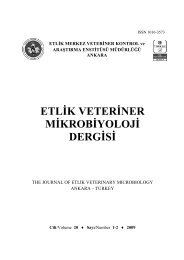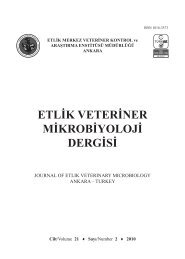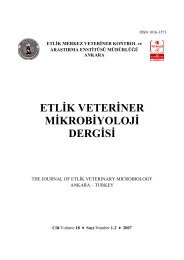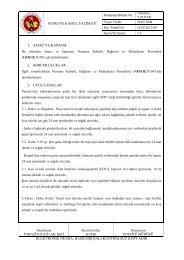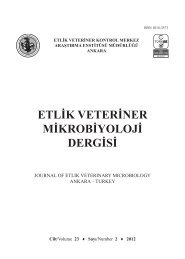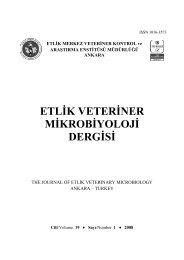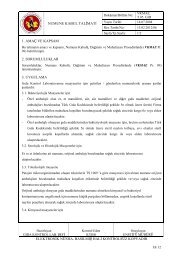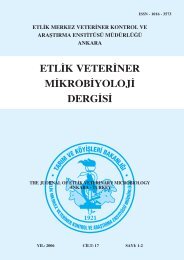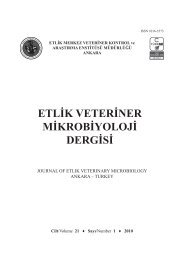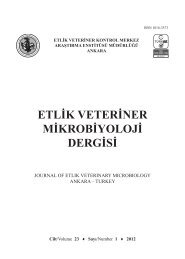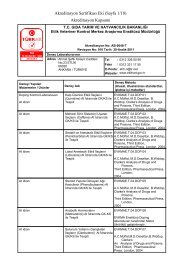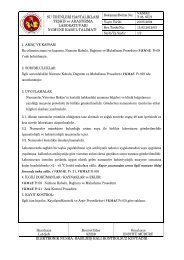etlik veteriner mikrobiyoloji dergisi - veteriner kontrol merkez ...
etlik veteriner mikrobiyoloji dergisi - veteriner kontrol merkez ...
etlik veteriner mikrobiyoloji dergisi - veteriner kontrol merkez ...
You also want an ePaper? Increase the reach of your titles
YUMPU automatically turns print PDFs into web optimized ePapers that Google loves.
56<br />
Sırıken B ve ark. Etlik Vet Mikrobiyol Derg, 22, 54-60, 2011<br />
a major threat to public health in many countries<br />
due to the persistent circulation of resistant bacteria<br />
in the environment and the possible contamination<br />
of water and food such as poultry meats (30).<br />
Biofilm production has been also reported in some<br />
enterococcal infections. However, there are limited<br />
reports about the prevalence of vancomycin resistance<br />
and biofilm production of enterococci isolated<br />
from poultry in Turkey.<br />
Therefore, the aim of this study was to investigate<br />
the occurence, vancomycine resistance<br />
and slime factor produciton of Enterococcus spp.<br />
namely clinically important species, E.faecalis and<br />
E.faecium, in chicken carcasses consumed in Samsun<br />
province, Turkey.<br />
Materials and Methods<br />
Sample collection: A total of 123 chicken carcasses<br />
were collected from different markets and butcher<br />
shops in the Samsun Province in North of the Turkey,<br />
between 2008 and 2009. These samples were<br />
analyzed immediately after procurement.<br />
Table 1. The oligonucleotide primers used in the study<br />
Enterococcus spp. isolation and identification:<br />
For the isolation, the whole carcass was transferred<br />
into a sterile polyethylene stomacher bag and rinsed<br />
with 225 ml 0.1% (wt/vol) of peptone water (Bacteriological<br />
peptone, Oxoid, Basingstoke, England) for<br />
1-2 min (rinse method). Following, the carcass was<br />
removed aseptically and the remaining rinsate in the<br />
bag was cultured for microbiological analysis after<br />
10-fold serial dilutions (up to 10-5) for each sample<br />
in sterile peptone water (PW). Subsequently, each<br />
of these dilutions was inoculaed onto Slanetz and<br />
Bartley Medium (Oxoid CM 377) by spread plating<br />
technique (100 µl) and, the plates were incubated<br />
aerobically at 37°C for 24-48 h. (31). Enterococcus<br />
spp. colonies (bright red coloured colonies or pale<br />
colonies with bright red coloured centre) were selected<br />
and subcultured onto Triptone Soy Agar (CM<br />
131, Basingstoke, England) plates to identify the<br />
isolates at the genus level using biochemical tests<br />
(10).<br />
DNA extraction: In this study, the DNAs used for<br />
PCR analysis were extracted using boiling method.<br />
Target gene Primer names Oligonucleotide sequences Amplicon size (bp)<br />
ddl<br />
ddl<br />
tuf<br />
vanA<br />
vanB<br />
vanC1/2<br />
vanD<br />
vanE<br />
DD13 F 5’-CACCTGAAGAAACAGGC-3’<br />
DD3-2 R 5’-ATGGCTACTTCAATTTCACG-3’<br />
FAC1-1 F 5’-GAGTAAATCACTGAACG-3’<br />
FAC2-1 R 5’-CGCTGATGGTATCGATTCAT-3’<br />
E. faecalis 476<br />
E. faecium 1091<br />
ENT1 F 5’-TACTGACAAACCATTCATGATG-3’ Enterococcus spp. 112<br />
ENT2 R 5’-AACTTCGTCACCAACGCGAAC-3’<br />
EA1 F 5’-GGGAAAACGACAATTGC -3’<br />
EA2 R 5’- GTACAATGCGGCCGTTA -3’<br />
EB3 F 5’-ACGGAATGGGAAGCCGA -3’<br />
EB4 R 5’- TGCACCCGATTTCGTTC -3’<br />
EC5 F 5’- ATGGATTGGTAYTKGTAT-3’*<br />
EC8 R 5’- TAGCGGGAGTGMCYMGTAA -3’*<br />
ED1 F 5’- TGTGGGATGCGATATTCAA -3’<br />
ED2 R 5’- TGCAGCCAAGTATCCGGTAA -3’<br />
EE1 F 5’- TGTGGTATCGGAGCTGCAG -3’<br />
EE2 R 5’- ATAGTTTAGCTGGTAAC -3’<br />
VAN A 732<br />
VAN B 647<br />
VAN C 815/827<br />
VAN D 500<br />
VAN E 430<br />
vanG EG1 F 5’- CGGCATCCGCTGTTTTTGA -3’ VAN G 941<br />
EG2 R 5’- GAACGATAGACCAATGCCTT -3’



